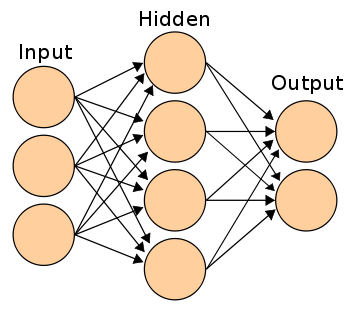Code: Select all
Const C_maxInputs = 5000,C_maxNPL = 500,C_maxLayers = 5
Const C_maxNet = 16'50000 'Max number of neurons any single neruon can be linked to(On a per neuron basis, so 2 neurons is limit*2 and so on, up to n(Inifinity)
Const nBias = - 1 'Do not change!(cue everyone changing it, crashing their machines..;->
Const C_sypAct = 1 'Activation value. Change to suit your needs.
Const V_maxVec = 500
Const c_maxHis = 500
Type vector
size as integer
v(V_maxVec) as single
End Type
Type neuron
numNet as integer
weight(C_maxNet+1) as single
net (C_maxNet) as neuron ptr
End Type
Type nLayer
neuron(C_maxNPL) as neuron ptr
numNeurons as integer
numIn as integer
End Type
Type neuralNet
numInputs as integer
numOutputs as integer
numLayers as integer
numNPL as integer
nLayer(C_maxLayers) as nLayer ptr
End Type
Dim shared vTmp as vector ptr'IO vector used by neural nets
Dim shared as neuron ptr nFire(c_maxHis)
Dim shared as neuron ptr nNull(c_maxHis) 'For the learning, history of a cycles, null and fired neurons.
sub initFFnet()
vTmp = New vector
End sub
Function neuron(numNet as integer) as neuron ptr
dim as neuron ptr neur = New neuron
For i as integer= 1 To numNet + 1
neur->weight(i) = Rnd(1)*.4
Next
neur->weight(C_maxNet+1) = Rnd(1)*.6
Return neur
End Function
Function nLayer(numNeurons as integer,numIn as integer) as nLayer ptr
dim as nLayer ptr nLay = New nLayer
nLay->numNeurons = numNeurons
nLay->numIn = numIn
For n as integer=1 To numNeurons
nLay->neuron(n) = neuron(numIn)
Next
Return nLay
End Function
sub linkLayers(l1 as nLayer ptr,l2 as nLayer ptr,chains as integer = 0, preser as integer = 1) '1> 2<> 3<
For n as integer= 1 To l1->numNeurons
If preser=0 then
l1->neuron(n)->numNet=0
End If
For t as integer= 1 To l2->numNeurons
l1->neuron(n)->net(t+l1->neuron(n)->numNet) = l2->neuron(t)
Next
l1->neuron(n)->numNet = l1->neuron(n)->numNet+l2->numNeurons
Next
If chains<>0 then linkLayers(l2,l1,0,preser)
End sub 'To double chain two layers, set chain to true
Function neuralNet(numInputs as integer,numHidden as integer,numOutputs as integer,populate as integer= 1,initVecTmp as integer = 1) as neuralNet ptr
dim as neuralNet ptr outp = New neuralNet
outp->numInputs = numInputs
outp->numOutputs = numOutputs
outp->numLayers = numHidden
If populate then
outp->nLayer(1) = nLayer(numInputs,numInputs)
outp->nLayer(2) = nLayer(numHidden,numInputs)
outp->nLayer(3) = nLayer(numOutputs,numHidden)
linkLayers(outp->nLayer(1),outp->nLayer(2),1)
linkLayers(outp->nLayer(2),outp->nLayer(3),1,1)
End If
Return outp
End Function
sub punishNet()
If c_maxHis=0 then End
For j as integer = 1 To c_maxHis
If nFire(j) <>0 then
For n as integer = 1 To c_maxNet
nFire(j)->weight(n) = nFire(j)->weight(n) - rnd(1)
Next
EndIf
If nNull(j) <>0 then
For n as integer = 1 To c_maxNet
nNull(j)->weight(n) = nNull(j)->weight(n) + rnd(1)
Next
EndIf
Next
End Sub
sub rewardNet()
If c_maxHis=0 then End
For j as integer = 1 To c_maxHis
If nFire(j) <>0 then
For n as integer = 1 To c_maxNet
nFire(j)->weight(n) = nFire(j)->weight(n) + 0.05
Next
EndIf
If nNull(j) <>0 then
For n as integer = 1 To c_maxNet
nNull(j)->weight(n) = nNull(j)->weight(n) - 0.02
Next
EndIf
Next
End Sub
sub clearHistory()
For j as integer = 1 To c_maxHis
nFire(j) = 0
nNull(j) = 0
Next
End sub
sub pushVector(in as vector ptr,v as single)
If in->size < V_maxVec then in->size=in->size+1 Else exit sub
If in->Size > 1 then
For i as integer=in->size-1 To 1 Step - 1
in->v(i+1)=in->v(i)
Next
EndIf
in->v(1) = v
End sub
Function sigmoid(in as single,round as single) as single
Return ( 1. / (1. + Exp(-in / round)))
End Function
sub FFnetCycle(in as neuralNet ptr) ' input->[?> hidden ?> output >]->user/GA
dim tWeight as single
clearHistory
For layer as integer = 1 To 3
For i as integer = 1 To in->nLayer(layer)->numNeurons
tWeight = 0
For n as integer = 1 To in->nLayer(layer)->numIn
tWeight = tWeight + (vTmp->v(n) * in->nLayer(layer)->neuron(i)->weight(n))
Next
tWeight = tWeight + (in->nLayer(layer)->neuron(i)->weight(c_maxNet+1)) * nBias
pushVector(vTmp,sigmoid(tWeight,C_sypAct))
If vTmp->v(1) > in->nLayer(layer)->neuron(i)->weight(C_maxNet+1) then
For j as integer = 1 To c_maxHis
If nFire(j) = 0 then
nFire(j) = in->nLayer(layer)->neuron(i)
Exit for
End If
Next
Else
For j as integer= 1 To c_maxHis
If nNull(j) = 0 then
nNull(j) = in->nLayer(layer)->neuron(i)
Exit for
End If
Next
End If
Next
Next
End sub
sub setInput(i as integer,v as single)
If i>vTmp->size then vTmp->size = i
vTmp->v(i) = v
End sub
Function getInput(i as integer)as single
Return vTmp->v(i)
End Function
sub clearNetIO() 'needed after every cycle's results/inputs are not needed.
vTmp->size = 0
vTmp->v(1) = 0
End sub
Function getOutput(net as neuralNet ptr,n as integer,sum as integer = 0) as integer
'If sum=0 then Return int(.5+ net->nLayer(3)->neuron(n)->weight(C_maxNet+1))
For j as integer = 1 To c_maxHis
If nFire(j) = net->nLayer(3)->neuron(n) then return 1
If nNull(j) = net->nLayer(3)->neuron(n) then return 0
Next
return 0
End Function
A neural net is a system that can learn through virtual "neurons".
It's possible to define a network with many variable as inputs; the network will return some bits as outputs. At first, it will return random results, but it's possible to train it (by "rewarding" and "punishing" it) to return correct results. The net will learn.
Here is a sample (with two inputs, and two outputs)
Code: Select all
initFFnet
dim shared neur as neuralNet ptr
neur=neuralNet(2,8,2)
dim shared as integer val_out
dim i as single
dim c as string
dim e as integer
do
input i,e
clearNetIO
setinput(1,i)
setinput(2,e)
FFnetCycle(neur)
? getOutput(neur,1), getOutput(neur,2)
print "is this correct?":c=ucase(input(1))
If c<>"Y" Then punishnet():?"No" else rewardnet:?"Yes"
loopCode: Select all
for x as integer=0 to 100
if rnd(1)>.2 then i=1-i
if rnd(1)>.2 then e=1-e
clearNetIO
setinput(1,i)
setinput(2,e)
FFnetCycle(neur)
if getOutput(neur,1)=e and getOutput(neur,2) =i then c="Y" else c="N"
If c<>"Y" Then punishnet():x=0 else rewardnet
next
Neural networks are used for many tasks, such as OCR or speech recognition.

